If you’ve been following fishing on Lake of the Woods the last 10 years, odds are good you’ve heard or even had days where you motor out to a random area on the south basin and never have to move, fish after fish with barely anytime to get in lunch.
Now fast forward to this year, things have changed without and doubt. This winter fishing on the south basin of Lake of the woods was down right dismal. Many people reported catching more Tulibees and Whitefish than they did walleyes and sauger.
What’s the reason why all of these fish are gone? That’s a very good question, and one that has yet to be answered.
South Side Slowdown
The summer of 2014 was one for the record book with an 85 year record flooding from the abundance of rain and the runoff definitely negatively affected the water clarity which carried out through the entire winter fishing season. Some hypothesis floating around say the bait fish got pushed out of the basin and have yet to return. Are these fish gone? In speaking the the Tom Heinz, Large Lake Specialist out of Baudette, reports that there is still a healthy population of fish on the south side of the lake with many year classes represented boasted by the 2011 year class of 12-13 inch fish. “It may simply be a distribution factor, and people are just not finding them in traditional areas” says Heinz.
So what does this mean if you want to head to Lake of the Woods this summer? Head to the north my friend! The Northwest Angle and north up into Canada is the place to be! A lot of those fish from the south side are rumored to be still hanging from Knight & Bridges, to Garden and further north. The
This winter, fishing was excellent in the NWA and June is one of the best times to get on a stellar Walleye bite!
There are a few things to keep in mind if you plan on fishing the Northwest Angle and Canadian waters.
The first order of business is getting there. You can travel via boat from the south shore of lake, with Arneson’s Rocky Point being the closest launching point. Traveling by boat can save you the hassle of crossing into Canada and then back into the United States. Even if you have a DWI or other offense on your record, you still can fish the Angle by traveling by water. Generally, traveling by water is much faster than driving around with the average trip being about an hour, but be careful if mother nature rears her ugly head. Be sure to cross early in the morning and under favorable conditions because things can get nasty in a hurry on the big lake. Also if you have to be home at a specific time, crossing by water might not be the best option, as big blows can last for days, keeping you stranded in the NWA.
It is highly recommended to have Passport or Enhanced Minnesota drivers license to cross the border. According to the US Border Partrol
“Utilizing an approved travel document is highly recommended for travelers. Utilizing these documents wil ease the inspection process and reduce wait times at the border because the information can be scanned and does not have to be entered manually. If you have a passport please bring it.”
It is highly recommended but if you do not have a passport you can get into Canada with a Drivers License, and re-enter the United States with a Drivers License and a United States Birth Certificate.
If you plan on fishing Canada, a Remote Area Border Crossing permit, more commonly referred to as an RABC is great to have, as it will reduce the hassle of calling in and out of Canada everyday. You can order one via mail which takes around a month to receive or you can stop at the Rainy River/Baudette Canadian border crossing and buy one right on the spot. You’ll also want to head into Canada with a full tank of gas in your truck and boat, as the gas is more expensive in Canada and in the Northwest Angle.
The second option is driving to the Northwest Angle. This calls for crossing the border at either Warroad/Sprauge if you are coming from the east or the Roseau/South Junction crossing from the west. Keep in mind the Roseau crossing is closed from midnight-8am, while the Warroad crossing is open 24 hours a day.
The drive around the lake is 60 miles, and for the first 40 it isn’t too bad. There is 20 miles of gravel which can be a slow go with a boat in tow. You’ll definitely want some sort of rock guard for your boat if you do decide to drive.
You’ll cross back into the United States and soon after you’ll see signs for Jim’s Corner. This is a phone booth where you’ll call into the United States, saying you’re entering into the NWA. They’ll commonly ask for you and your passenger’s full names, license plate numbers, and places of residence. From Jim’s corner it’s a short drive to many of the resorts in the area. Young’s Bay Resort is considered the hub for the NWA with ample parking, a boat launch, lodging and located within walking distance to Jerry’s Restaurant and Bar.
Fishing
It’s considered one of the premiere destinations for many fisherman targeting walleyes in the midwest and around the entire country. Spanning just over 950,000 acres, Lake of the Woods has just about every type of fishing you’re after. The month of June can be absolutely incredible for Walleyes and Pike.
It’s a great place to try new techniques and hone in your skills because the fish are seemingly aways willing to bite. Here are a few of my go to techniques for early summer.
Jigging
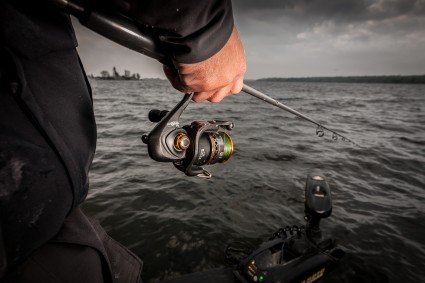 I was obliged to hit on this first, well because it is hands down been the most versatile and productive technique this time of year. Throw in a dozen short shanked 1/8, 1/4, and 3/8 oz jigs and you’re pretty much set. The best colors are chartreuse, chartreuse/green and parrot. Bait can be a little tricky in this part of the state, as often the minnows are either very small, out of stock or wildly expensive. Bringing a half flat of crawlers packed in paper, not dirt, is easy, inexpensive and fish love them. The other reason minnows are hard, is because if you plan on fishing Canada then you need to buy the minnows in Canada and have a receipt to prove it. They are also sticklers about it!
I was obliged to hit on this first, well because it is hands down been the most versatile and productive technique this time of year. Throw in a dozen short shanked 1/8, 1/4, and 3/8 oz jigs and you’re pretty much set. The best colors are chartreuse, chartreuse/green and parrot. Bait can be a little tricky in this part of the state, as often the minnows are either very small, out of stock or wildly expensive. Bringing a half flat of crawlers packed in paper, not dirt, is easy, inexpensive and fish love them. The other reason minnows are hard, is because if you plan on fishing Canada then you need to buy the minnows in Canada and have a receipt to prove it. They are also sticklers about it!
Casting Cranks
June is a fantastic month for targeting walleyes with crankbaits and for me personally one of the most fun ways to catch them. A few different types of cranks will carry you a long way, and work in a number of different situations. The storm ThunderCraw or any similar crawfish colored or shaped bait is a go to right off the bat. X-Raps are another great bait to have in the tackle box. Sizes 6 & 8 seem to be the best in Clown, Gold and Silver Blue.
Hang around IDO much? Then you’ve probably heard about the Rippin’ Rap. Yep, they work like a dream up on LOTW too. Gold Chrome, Firetiger are great colors in #4 and #5.
Lastly, a bait I’ve yet to try on LOTW but one I have extremely high hopes for is the Shadow Rap. Gold I have a feeling is going to be lights out on the walleyes, and don’t forget to pick up the Shadow Rap Deep too, as you can target some of the spots around 10 feet more effectively.
Bottom Bouncing
A lot of people probably won’t much care for this statement, but I’d suggest leaving your big 2 oz lead bouncers at home. I see tons of people using this approach but many days after examining their bags and trying the technique first hand, I’d opt for a jig any day of the week.
In saying that, a similar technique; Rigging with a small weight on the shallow sand can be very productive.
Trolling
Trolling really starts to shine when you get down towards Garden Island, trolling the breaks or off the edge in proximity to structure. I’ve had some of my best days pulling leadcore with a 15′ fluoro leader and a handful of baits. Utilizing some of the new leadcore technology, such as Sufix 832 Advanced Leadcore, changes the ballgame as you are able to make more precise trolling passes with less line out and still targeting the right depths.
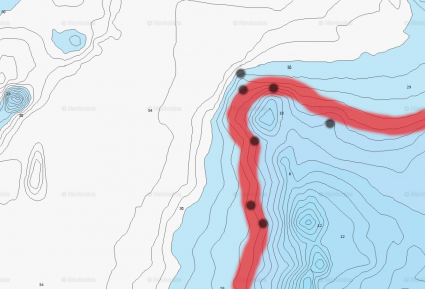
Trolling large points is a great approach to catching fish in Little Traverse and around Garden Island
Working the boat around 2-2.5mph and adjusting faster and slower depending on the mood of the fish can be dynamite.
Some of my favorite baits are the Scatter Rap Shad in Gold Albernus, Husky Jerk #8s, and Storm’s Deep Baby Thundersticks. Start with a couple different lures in different colors and body shapes and start to build a pattern. Once you get dialed in, fishing can be phenomenal!
Locations
The NWA and canadian shield area hold prime spawning areas and many fish end up pushing up into the area from the lower basin of the lake. It’s a recipe for disaster, for the fish! The beauty of fishing the Angle is you can run 50 miles a day or 200 yards from the landing and find fish easily. If you have a smaller boat, no problems, there are hundreds of spots you can still fish close by, even when it’s really windy.
During the month of June, the fish are post-spawn and considerably grouped up compared to later in the summer. There are a few key pieces of structure I target, which often hold the largest fish.
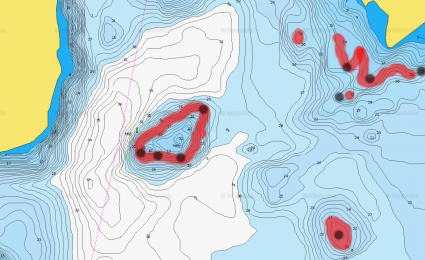
Humps adjacent to shore are great spots in June. Areas highlighted in red are some of the most productive areas while the black dots are often the spot on the spot.
Offshore humps topping out in 13-20 feet of water, adjacent to shoreline structure is the name of the game! The reason why shoreline structure is key in this equation is because the majority of the big fish are post-spawn and these humps are one of the pieces of structure they relate to after the spawn. Not all shoreline structure is created equal. This is where good electronics come in handy! Using your sidescan feature, it’s easy to determine where there is mixed rubble and rock. Flat sloping rocks is not what your looking for as it doesn’t hold any bait nor is adequate spawning habitat.
Fishing the breaks off of this shoreline structure is another quality play. Position your boat off the edge of the break and pitch jigs or cranks on top of the structure in under 10 feet of water and work it down the break.
If you’re a newbie to the NW Angle, here are a few spots which consistently hold fish year after year. It will be something which helps get your feet wet, and make for a successful first day!
A great spot in the US is Little Oak Island. There are two points with humps coming off the east side which are often great fish producers.
This year Canada seemed to hold much better fishing with almost every spot holding numbers of Walleyes. One of my favorite spots is off the north side of Cyclone Island. Cyclone island is located on the West side of the Sturgeon Channel and north of Oak Island holds some great spots. Humps, like the one highlighted in red are great producers!
Don’t be intimidated by vastness of Lake of the Woods. Every trip we take a day or two to fish areas we never have targeted, essentially going in blind and have never struggled finding fish. It’s truly one of Minnesota’s finest gems.
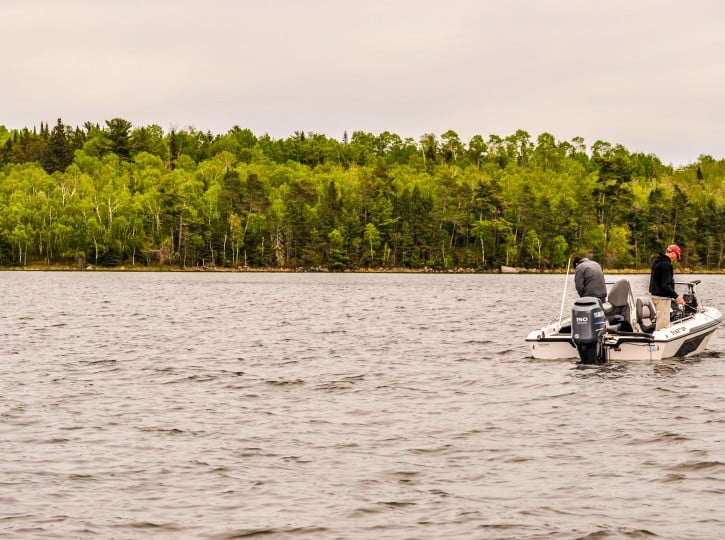
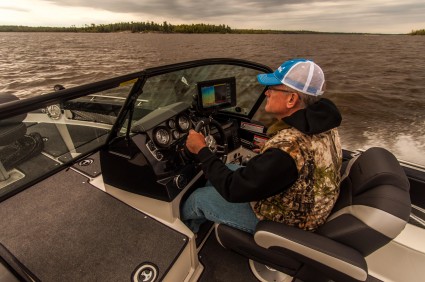
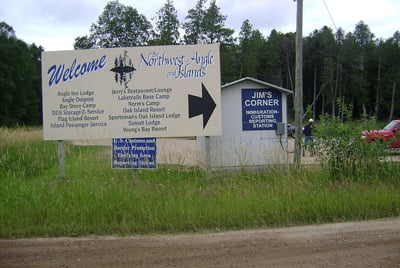
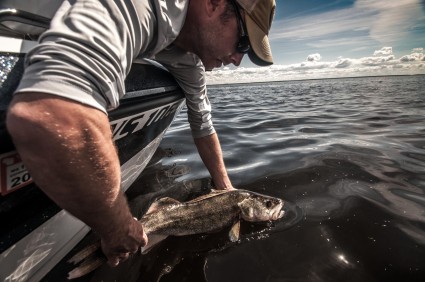
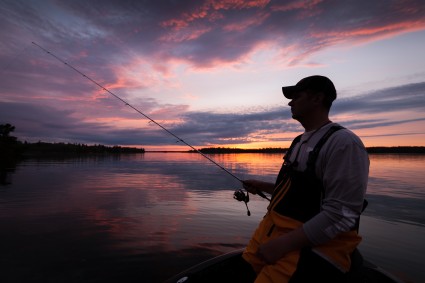
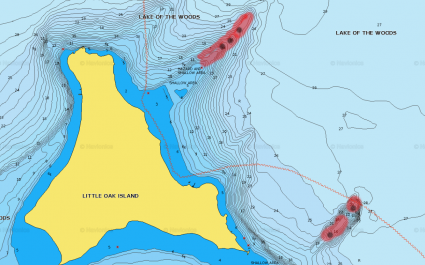
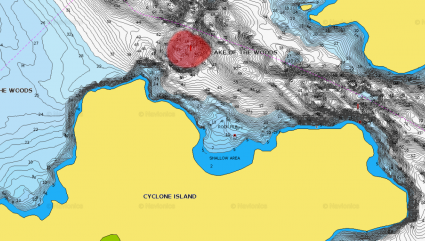
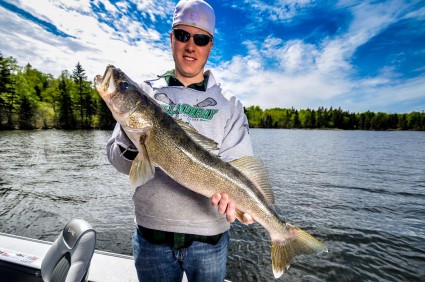
Great stuff Ben, will be studying up here to hopefully replicate your successes in the coming week or two. Thanks for the info!
Joel